March 2023
Posted: 3/22/2023 4:17:09 PM
The first rule of holes is when you find yourself in one, stop digging. That’s the challenge when it comes to reducing carbon emissions in the United States as laid out by Jesse Jenkins during a 30-minute presentation, “Pathways to Zero: Decarbonizing the Transportation Sector,” at the NJTPA Board of Trustees meeting on March 13, 2023.
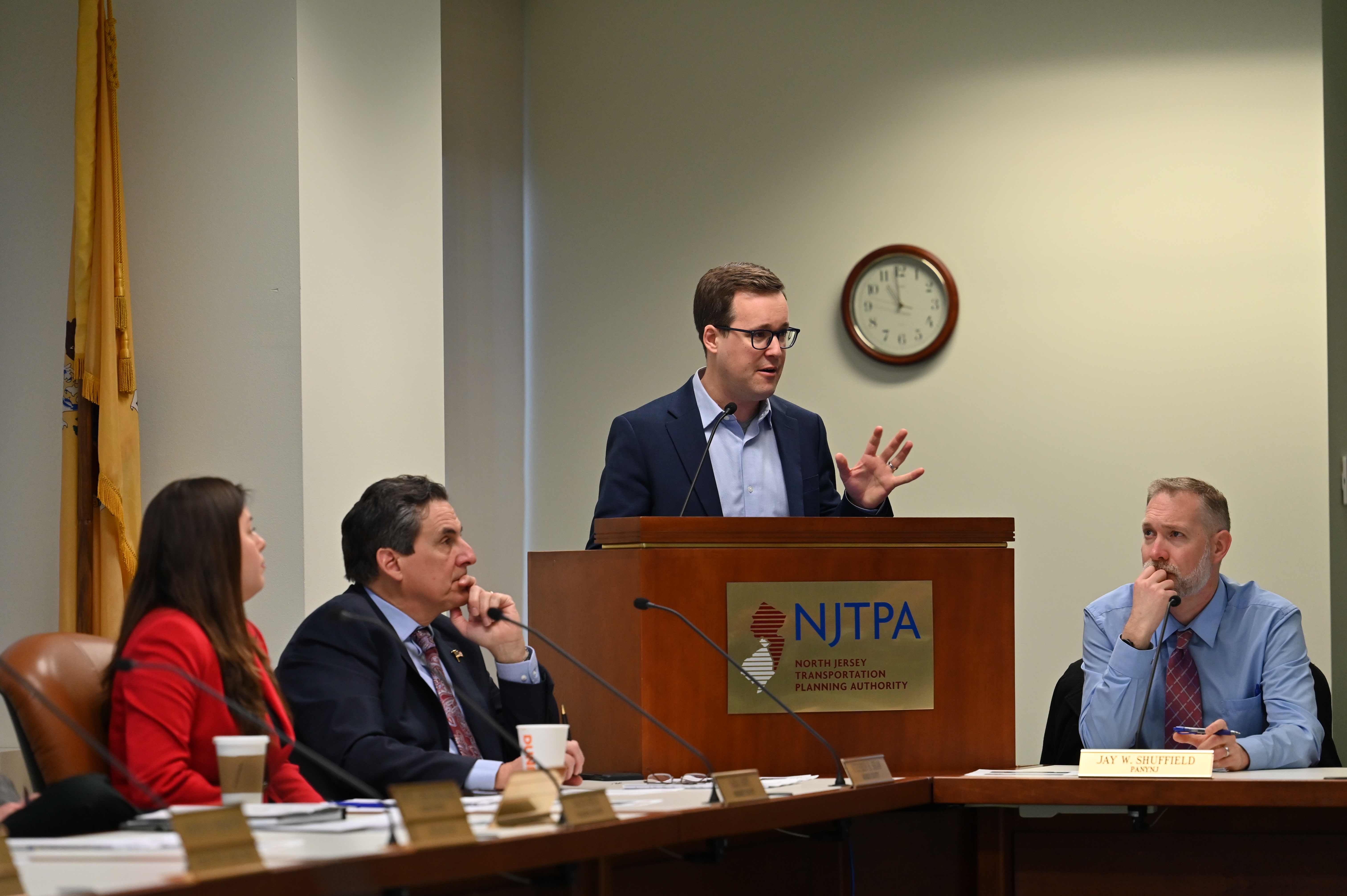 Net zero carbon emissions in the United States is the point “where we stop digging ourselves a deeper hole when it comes to the challenges and damages and impacts of a changing climate,” he said. An assistant professor of Mechanical and Aerospace Engineering at the Andlinger Center for Energy and the Environment at Princeton University, Jenkins outlined the progress and challenges of the U.S. goals of reducing emissions by half by 2030 and reaching zero by 2050.
Net zero carbon emissions in the United States is the point “where we stop digging ourselves a deeper hole when it comes to the challenges and damages and impacts of a changing climate,” he said. An assistant professor of Mechanical and Aerospace Engineering at the Andlinger Center for Energy and the Environment at Princeton University, Jenkins outlined the progress and challenges of the U.S. goals of reducing emissions by half by 2030 and reaching zero by 2050.
Since carbon emissions in the U.S. peaked at 6.6 billion metric tons from 2005 to 2007, there’s been a decline of about 1 billion tons. But the pace of carbon reductions each year must triple from the 2 percent realized on average over the last decade to 6 percent to get to the 2050 goal.
“The challenge is to go faster, faster, faster. And that requires foresight, public policy and investment, and significant efforts to overcome coordination challenges so that we can move faster collectively,” Jenkins said.
The electricity sector is really the linchpin, according to Jenkins. The U.S. must double the current amount of carbon-free electricity generated, building upon the growing contributions from wind and solar power.
The Inflation Reduction Act (IRA) will help do that, closing between half to two-thirds of the 1.5-billion ton gap between the current pace of carbon reduction and what is needed to roll back emissions to half of those in 2005 by 2030. Both through subsidies and driving clean energy costs down over time, the law will “make it easier and cheaper for households and businesses across the country to pick the clean option over the dirty option” according to Jenkins.
The academic REPEAT consortium, which Jenkins leads, estimates that the law will enable the U.S. to reach about 42 percent by 2030, shy of the 50 percent goal but a substantial reduction.
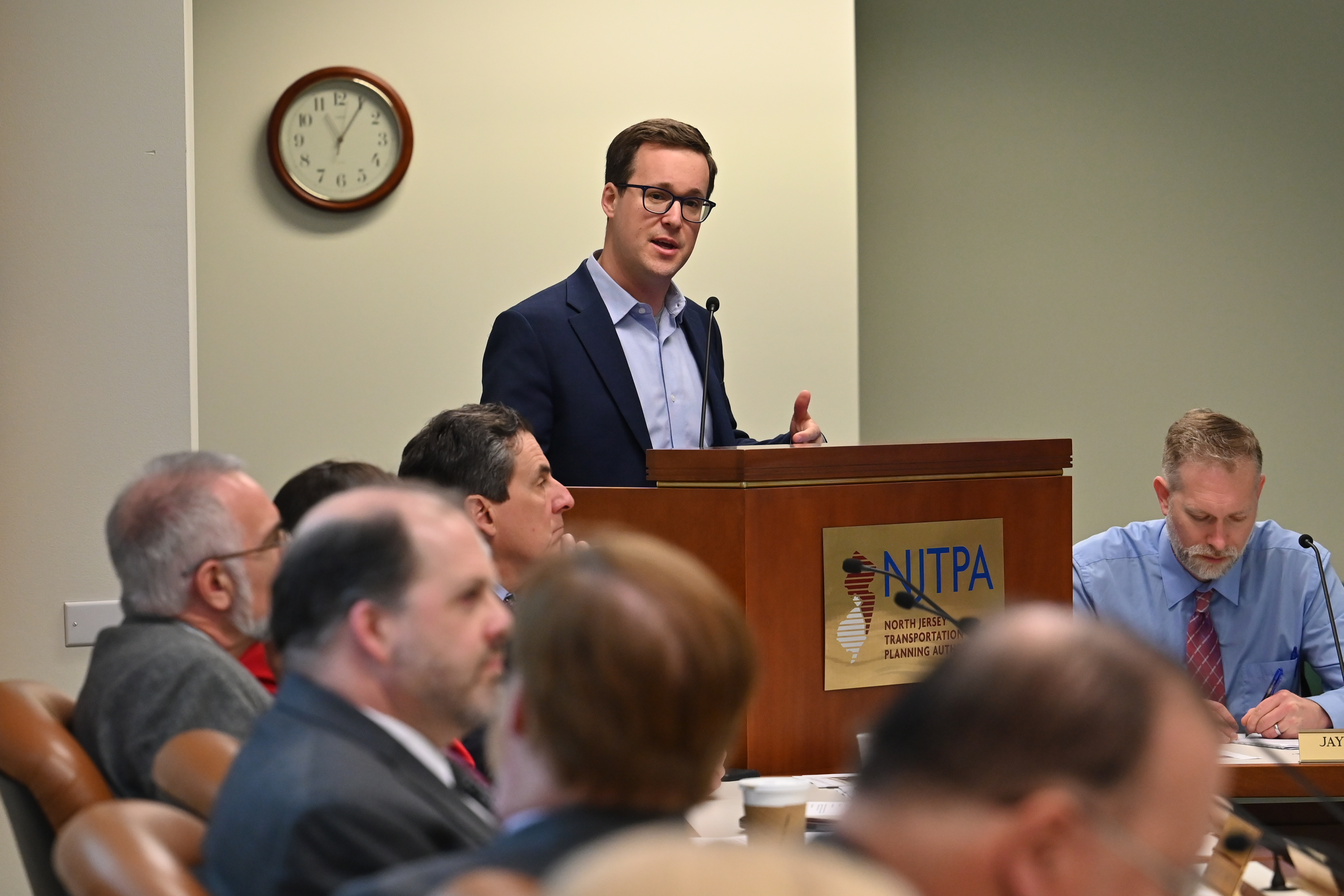 But he said that estimate only accounts for the direct effect of the law. He said the law could also accelerate the rate of reductions, as states, cities, and companies increase their “climate ambition” in response to the reduced cost of clean energy and other climate options. This is already being seen in New Jersey. Gov. Phil Murphy announced moving the target for 100-percent carbon-free electricity from 2050 to 2035 to take advantage of all the new affordable options created by the law.
But he said that estimate only accounts for the direct effect of the law. He said the law could also accelerate the rate of reductions, as states, cities, and companies increase their “climate ambition” in response to the reduced cost of clean energy and other climate options. This is already being seen in New Jersey. Gov. Phil Murphy announced moving the target for 100-percent carbon-free electricity from 2050 to 2035 to take advantage of all the new affordable options created by the law.
In addition to a $7,500 tax credit for a new electric vehicle (EV), there’s a $4,000 tax credit for the purchase of used EVs, which is important because most Americans don’t ever buy or lease a new vehicle, Jenkins said. There also are various incentives for installing charging stations and purchasing charging equipment and for purchase of clean light, medium and heavy duty vehicles used by businesses and local governments.
With subsidies in the IRA, purchasing an EV he said is becoming “a no-brainer for households.” About 5 percent of all vehicles were EVs in 2021 and that grew to about 8 percent in 2022. A similar 60-percent expansion is expected in 2023. Continued growth at that pace could achieve the goal of 100 percent of new vehicles being electric well before the 2035 targets set by New Jersey and other states, he said.
To prepare for this growing demand, Jenkins said, the U.S. must make investments in the electric grid and other infrastructure not seen in decades. But he said strains on the grid could be lessened if consumers and households were given incentives for efficient charging practices, including charging at night and less frequently. He noted that using a Level 2 home charger has the energy demand of plugging in 12 window-mounted air conditioners.
For the first time in history, he said the IRA has aligned the full financial might of the federal government behind clean energy transition. The challenge he said is “how fast can we scale up all of our efforts; how fast can we move to take advantage of the opportunities.”
A recording of the presentation from the March 13, 2023 Board meeting is available here. The slide presentation is here.
Posted: 3/15/2023 10:23:55 AM
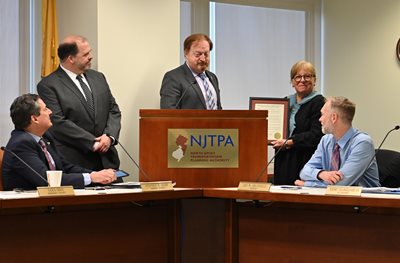 The NJTPA’s immediate-past-Chair, former Morris County Commissioner Kathryn A. DeFillippo, was honored by the NJTPA Board of Trustees at its March 13, 2023 meeting. Commissioner DeFillippo retired last year after serving three terms as a county commissioner. She represented Morris County on the NJTPA Board since 2014 and was elected NJTPA Chair for the 2020-2021 term.
The NJTPA’s immediate-past-Chair, former Morris County Commissioner Kathryn A. DeFillippo, was honored by the NJTPA Board of Trustees at its March 13, 2023 meeting. Commissioner DeFillippo retired last year after serving three terms as a county commissioner. She represented Morris County on the NJTPA Board since 2014 and was elected NJTPA Chair for the 2020-2021 term.
NJTPA Chair John W. Bartlett, a Passaic County Commissioner, and NJTPA Executive Director David Behrend presented former Commissioner DeFillippo with a framed resolution on behalf of the Board.
The Board resolution highlights former Commissioner DeFillippo’s “capable, confident, and collaborative leadership to meet the many challenges of a regional and global pandemic.” After just one in-person meeting as Chair in January 2020, Commissioner DeFillippo several weeks later helped guide the NJTPA as it pivoted to all-virtual operations.
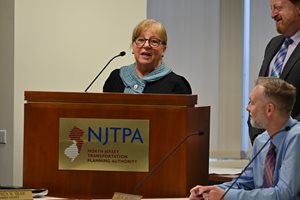 “I am very proud of what this Board, and particularly our staff, was able to accomplish during a time when we were all trying to figure out how to make work happen,” said former Commissioner DeFillippo at the March 13 Board meeting. “My thank you is to the Board and the staff for everything you did to keep the NJTPA moving in the right direction.”
“I am very proud of what this Board, and particularly our staff, was able to accomplish during a time when we were all trying to figure out how to make work happen,” said former Commissioner DeFillippo at the March 13 Board meeting. “My thank you is to the Board and the staff for everything you did to keep the NJTPA moving in the right direction.”
In his remarks, Chair Bartlett emphasized, “It really took a special kind of leadership and judgement to cope with all of [the pandemic’s] challenges.”
“Kathy moved our agency forward through adoption of an updated long-range plan; progress on the Morris Canal Greenway and other trails; ongoing critical investment in roads and bridges; and continued advocacy for safety,” he said.
NJTPA First Vice Chair John Kelly, an Ocean County Commissioner, commended the former chair for providing leadership and continuity through the pandemic and many virtual meetings, adding, “We didn’t get much of a chance to say ‘thank you;’ but now you’re here today, and we can all just say ‘thank you’ for your leadership during those difficult times.”
Even before former Commissioner DeFillippo’s term as NJTPA Chair, Behrend noted that she had been “a great advocate for the NJTPA, participating in public engagement events; just a very hands-on member of our Board and we always appreciated that.”
Morris County Commissioner Stephen Shaw, who succeeded former Commissioner DeFillippo on the NJTPA Board said, “I’m honored now to be sitting in her seat; I know I have very big shoes to fill.”
The NJTPA previously released a video, posted on its YouTube channel, that also sums up former Commissioner DeFillippo’s service as NJTPA Chair.
Posted: 3/13/2023 9:12:14 AM
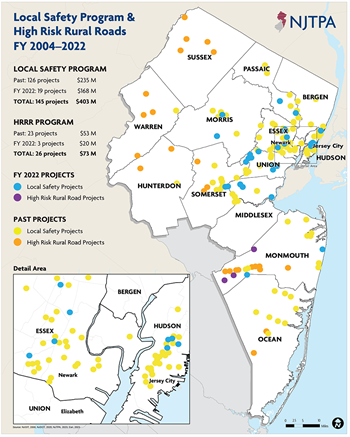 The Board of Trustees of the North Jersey Transportation Planning Authority (NJTPA) approved 19 projects totaling $188 million that will make travel safer for motorists, pedestrians and bicyclists throughout the region at its March 13, 2023 meeting. The projects were approved for grants through the NJTPA’s fiscal year 2022 Local Safety and High Risk Rural Roads programs, which provide federal funds to counties and cities for cost-effective solutions that can make an immediate impact on their target areas.
The Board of Trustees of the North Jersey Transportation Planning Authority (NJTPA) approved 19 projects totaling $188 million that will make travel safer for motorists, pedestrians and bicyclists throughout the region at its March 13, 2023 meeting. The projects were approved for grants through the NJTPA’s fiscal year 2022 Local Safety and High Risk Rural Roads programs, which provide federal funds to counties and cities for cost-effective solutions that can make an immediate impact on their target areas.
“These projects will deliver much-needed upgrades to roads and intersections, enhancing safety for all travelers,” said Passaic County Commissioner John W. Bartlett, the Chair of the NJTPA. Elements include new and upgraded traffic signals, modern roundabouts, turning lanes, pedestrian countdown signals, high visibility crosswalks, bike lanes, and more.
Projects will be funded in Essex County, Hudson County, Jersey City, Middlesex County, Monmouth County, Morris County, Passaic County, Somerset County and Union County. Fact sheets on each of the projects are available here.
Bartlett noted that the $188 million in projects represents a doubling of funding since the last round of Local Safety and High Risk Rural Roads projects in 2020. The increase, he said, “is the result of effective partnerships between the NJTPA and its member agencies.”
Since 2018, the NJTPA has provided consultant assistance to help interested member agencies apply for project funding under the two programs. This has increased the number of applications and the size of projects applied for. Consultants help with traffic data collection, crash diagrams, environmental impacts, alternative analysis and other application requirements.